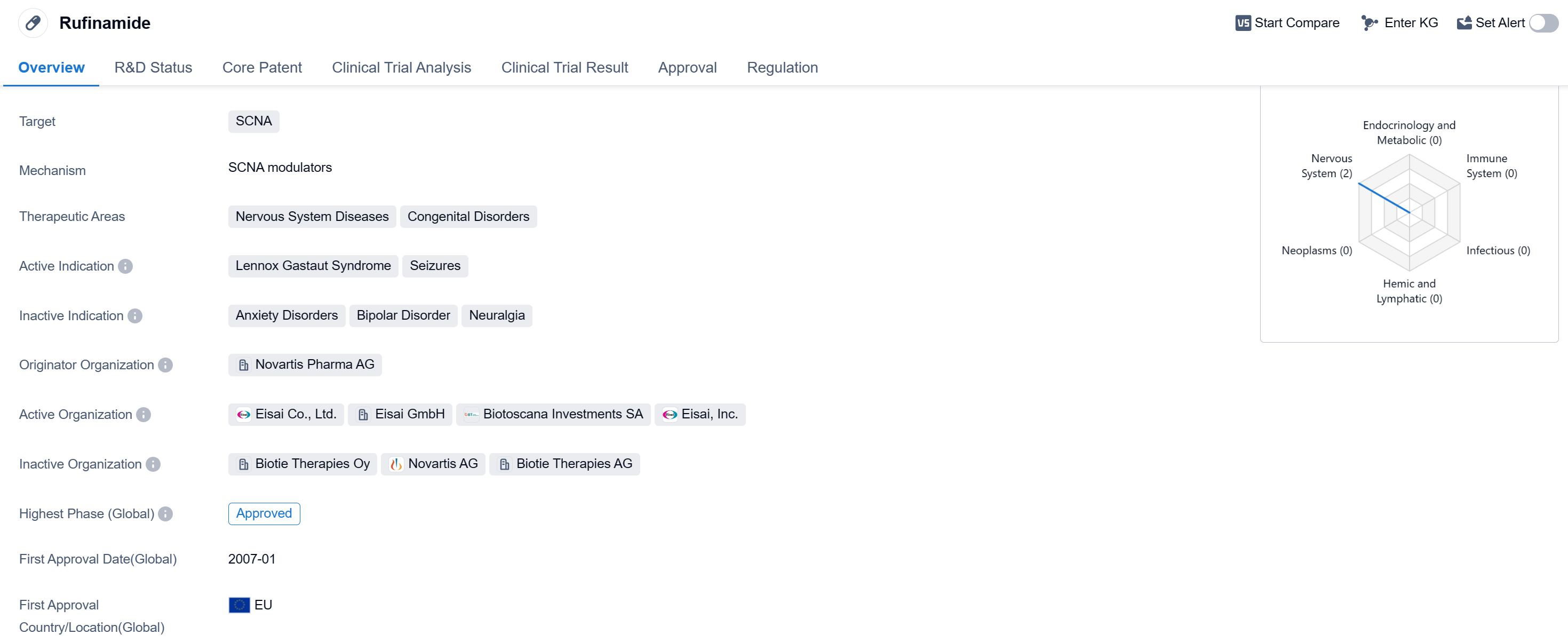Pharmaceutical Insights: Rufinamide's R&D Progress and its Mechanism of Action on Drug Target
Rufinamide's R&D Progress
Rufinamide is a small molecule drug that falls under the therapeutic areas of Nervous System Diseases and Congenital Disorders. It specifically targets SCNA, which is a protein involved in the functioning of sodium channels in the nervous system. The drug is primarily indicated for the treatment of Lennox Gastaut Syndrome, a severe form of epilepsy characterized by multiple types of seizures.
Rufinamide was first approved for use in the European Union in January 2007. It is important to note that the drug has received orphan drug designation, which means it is intended to treat rare diseases or conditions that affect a small number of patients. This designation provides certain incentives to the drug's manufacturer, Novartis Pharma AG, such as market exclusivity and financial benefits, to encourage the development of drugs for rare diseases.
The highest phase of development for Rufinamide is approved.
Rufinamide's approval in the European Union in 2007 signifies its initial entry into the market. It is possible that the drug has also received approvals in other countries or regions since then, but this information is not provided. As a small molecule drug, Rufinamide is likely to be administered orally, although specific details regarding its formulation and dosage are not mentioned.
👇Please click on the image below to directly access the latest data (R&D Status | Core Patent | Clinical Trial | Approval status in Global countries) of this drug.
Mechanism of Action for Rufinamide: SCNA modulators
SCNA modulators refer to substances or compounds that have the ability to modulate or regulate the activity of sodium channels (SCNAs). Sodium channels are integral membrane proteins that play a crucial role in the generation and propagation of action potentials in excitable cells, including neurons and muscle cells. These channels are responsible for the movement of sodium ions across the cell membrane, which is essential for the electrical signaling and communication within the nervous system.
SCNA modulators can have various effects on sodium channels, including altering their opening and closing kinetics, changing their ion selectivity, or modifying their overall activity. By targeting and modulating sodium channels, these compounds can have significant impacts on cellular excitability, neuronal signaling, and muscle contraction.
From a biomedical perspective, SCNA modulators can be of great interest in the development of therapeutic interventions for various conditions and diseases involving abnormal sodium channel activity. For example, certain neurological disorders, such as epilepsy and neuropathic pain, are associated with dysregulated sodium channel function. By selectively modulating the activity of these channels, SCNA modulators may offer potential treatment options by restoring normal neuronal excitability and reducing aberrant electrical activity.
It is important to note that SCNA modulators can have complex mechanisms of action and may interact with different types of sodium channels in specific ways. Therefore, their development and use require careful investigation and understanding of the specific sodium channel subtypes involved in a particular disease or condition. Additionally, the safety and efficacy of SCNA modulators need to be thoroughly evaluated through preclinical and clinical studies before they can be considered for therapeutic use.
Drug Target R&D Trends for Rufinamide
According to Patsnap Synapse, as of 13 Sep 2023, there are a total of 252 SCNA drugs worldwide, from 367 organizations, covering 214 indications, and conducting 7658 clinical trials.
Based on the analysis of the target SCNA, it is evident that Novartis AG, Pfizer Inc., and Fresenius SE & Co. KGaA are the companies growing fastest under the current target. The highest stage of development for the target SCNA is the approved phase, with a significant number of drugs targeting indications such as anesthesia, arrhythmias (cardiac), and pain.
Small molecule drugs dominate the drug type analysis, indicating intense competition in the market. However, other drug types such as interferons, antisense oligonucleotides, and AAV-based gene therapy show potential for future development.
China, the United States, and Japan are the countries developing fastest under the target SCNA. China, in particular, has made significant progress in drug development, with a high number of approved drugs.
Overall, the current competitive landscape for the target SCNA is dynamic, with multiple companies, indications, drug types, and countries involved. The future development of the target SCNA holds promise for innovative treatments and increased competition in the pharmaceutical industry.
👇Please click on the picture link below for free registration or log in directly if you have a freemium account, you can browse the latest research progress on drugs, indications, organizations, clinical trials, clinical results, and drug patents related to this target
Conclusion
In summary, Rufinamide is a small molecule drug developed by Novartis Pharma AG. It targets SCNA and is indicated for the treatment of Lennox Gastaut Syndrome and seizures. The drug received its first approval in the European Union in 2007 and has orphan drug status.






